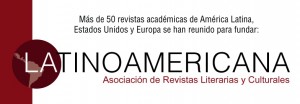Time and modern subjectivity in two chronicles of Ruben Darío
Abstract
“Barcelona” and “Málaga” are the two chronicles that open the first part of Tierras Solares, by Rubén Darío. This volume was published in 1904 and comprises the corpus of chronicles written in the context of a trip undertaken by the Nicaraguan poet through different cities in Europe.
In this work, we will focus mainly on a comparative analysis of both chronicles. They have been selected for the difference in tone and, at the same time, the proximity of their location within the work, which generates a counterpoint between the two that we can relate to modern subjectivity. To do this, we will analyze how the chronicler investigates the temporal density of the spaces he runs through. With regard to “Barcelona”, the subject positively perceives the progress of society and having left behind certain ancient customs. On the other hand, in the case of “Málaga, through a narrative in motion, which reproduces the movement of the subject along a walk through the city, the chronicler draws attention to different elements that have survived the advance of modern progress.
References
Bernabé, Mónica(2006). Vidas de artista. Bohemia y dandismo en Mariátegui, Valdelomar y Eguren (Lima, 1911-1922), Buenos Aires: Beatriz Viterbo Editora.
Bourdieu, Pierre (2001). Poder, derecho y clases sociales, Bilbao: Editorial Desclée de Brouwer.
Colombi, Beatriz (2004).Viaje intelectual. Migraciones y desplazamientos en América Latina (1880-1915), Rosario: Beatriz Viterbo Editora.
Darío, Rubén (1980). “El triunfo de Calibán”, en El modernismo visto por los modernistas, Barcelona: Guadarrama / Punto Omega.
---------- (1985). Poesía, Caracas: Biblioteca Ayacucho. [Prólogo de Ángel Rama], ---------- (1901). Peregrinaciones, Francisco Fuster [ed.], Sevilla: Editorial Renacimiento, 2014.
---------- (1901). España contemporánea, Noel Rivas Bravo [ed.], Sevilla: Editorial Renacimiento, 2013.
---------- (1904). “Tierras solares” en Rubén Darío, del símbolo a la realidad, Barcelona: Alfaguara, 2016.
González, Aníbal (1983). La crónica modernista hispanoamericana, Madrid: José Porrúa Turanzas.
Kraudy, Pablo (2010). “El pensamiento social y político de Rubén Darío” enRepertorio dariano: anuario sobre Rubén Darío y el modernismo hispánico. Managua: Academia Nicaragüense de la Lengua.
Litvak, Lily (1986). El sendero del tigre. Exotismo en la literatura española de finales del siglo XIX (1880-1913), Madrid: Taurus.
Maíz, Claudio (1996).El sujeto moderno hispanoamericano. Una lectura de textos episto- lares a Unamuno, Mendoza: Editorial de la Facultad de Filosofía y Letras, Universidad Nacional de Cuyo.
Montaldo, Graciela (1994).La sensibilidad amenazada, Buenos Aires: Beatriz Viterbo.
Ortiz, Renato (2004).Mundialización y cultura, Bogotá, Convenio Andrés Bello.
Paz, Octavio, (1990). Los hijos del limo.Del romanticismo a la vanguardia, Barcelona: Seix Barral.
Rama, Angel (1985). “Prólogo” en Darío, R. Poesía. Caracas: Biblioteca Ayacucho. Ramos, Julio (1989). Desencuentros de la modernidad en América Latina. Literatura y
política en el siglo XIX. Venezuela, El perro y la rana.
Rivas Bravo, Noel (2016). “Tierras solares”en Rubén Darío, del símbolo a la realidad, Barcelona: Alfaguara.
Rotker, Susana (1992).La invención de la crónica, Buenos Aires: Ediciones Letra Buena.
Scarano, Mónica (2016). “Las crónicas cosmopolitas de Rubén Darío y la mundialización de la cultura” [en línea].RECIAL. 10 (7). Disponible en: https:/ /revistas.unc.edu.ar/index.php/recial/article/view/15345. [consulta 10 de abril de 2022]
---------- (2017). “Rubén Darío, entre la crónica y el ensayo” [en línea] CELEHIS– Revista del Centro de Letras Hispanoamericanas. 26 (33), pp. 76-86. Disponible en: http://fh.mdp.edu.ar/revistas/index.php/celehis/article/view/2178. [consulta 10 de abril de 2022]
Schmigalle, Günther (2003). “Más apreciaciones sobre la imagen de España en Rubén Darío”. Anales de Literatura Hispanoamericana, 32, pp. 153-163.
Schulman, Ivan (ed.) (1987). Nuevos asedios al modernismo. Madrid: Alfaguara.
La aceptación de colaboraciones por parte de la revista implica la cesión no exclusiva de los derechos patrimoniales de los autores a favor del editor, quien permite la reutilización, luego de su edición en papel (postprint), bajo licencia Creative Commons Atribución-NoComercial-CompartirIgual 3.0
La cesión de derechos no exclusivos implica también la autorización por parte de los autores para que el trabajo sea alojado en el repositorio institucional de la UNT y difundido a través de las bases de datos que el editor considere apropiadas para su indización, con miras a incrementar la visibilidad de la revista y sus autores.























